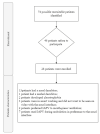Is Intermittent Abdominal Pressure Ventilation Still Relevant? A Multicenter Retrospective Pilot Study
- PMID: 37048537
- PMCID: PMC10095348
- DOI: 10.3390/jcm12072453
Is Intermittent Abdominal Pressure Ventilation Still Relevant? A Multicenter Retrospective Pilot Study
Abstract
Non-invasive ventilatory support (NVS) is a technique used to reduce respiratory work in neuromuscular diseases, preventing the progression of respiratory failure. NVS is usually administered via a nasal or an oronasal mask, causing discomfort, especially in patients ventilated for more than 16 h/day. Intermittent abdominal pressure ventilation (IAPV) differs completely from conventional NVS and consists of a portable ventilator and a corset with Velcro closures as the interface. In our study, the practicability and efficacy of IAPV were studied in three Italian centers monitoring 28 neuromuscular patients using IAPV who were then retrospectively analyzed. The primary outcomes were an improvement in hypoxemia and the normalization of hypercapnia, and the secondary outcome was an improvement in quality of life. Data were collected at baseline (T0) and after two hours of ventilation (T1), with follow-ups at three months (T2) and six months (T3). Statistical significance was found for PaCO2 over time (F (2.42) = 7.63, p = 0.001) and PaO2 (W = 0.539, p = 0.033). The time of NVS usage also significantly affected the quality of life (F (2.14) = 6.90, p = 0.010), as seen when comparing T0 and T3. As an alternative ventilation method, IAPV is still relevant today and could become a key part of daytime support, especially for patients who do not tolerate standard daytime NVS with an oral interface.
Keywords: Duchenne muscular disease (DMD); Pompe disease; amyotrophic lateral sclerosis (ALS); intermittent abdominal pressure ventilation (IAPV); neuromuscular diseases (NMD); non-invasive ventilation (NIV); quality of life; retrospective study.
Conflict of interest statement
The authors declare no conflict of interest.
Figures




Similar articles
-
Efficacy of new intermittent abdominal pressure ventilator for post-ischemic cervical myelopathy ventilatory insufficiency.Multidiscip Respir Med. 2019 Jan 28;14:4. doi: 10.1186/s40248-019-0169-4. eCollection 2019. Multidiscip Respir Med. 2019. PMID: 30705755 Free PMC article.
-
Intermittent abdominal pressure ventilation: feasibility and efficacy in neuromuscular disease. A case report.Monaldi Arch Chest Dis. 2021 Aug 3;91(4). doi: 10.4081/monaldi.2021.1828. Monaldi Arch Chest Dis. 2021. PMID: 34351105
-
Intermittent Abdominal Pressure Ventilation: An Alternative for Respiratory Support.Can Respir J. 2021 Aug 23;2021:5554765. doi: 10.1155/2021/5554765. eCollection 2021. Can Respir J. 2021. PMID: 34471441 Free PMC article.
-
Non-invasive Ventilation in Children With Neuromuscular Disease.Front Pediatr. 2020 Nov 16;8:482. doi: 10.3389/fped.2020.00482. eCollection 2020. Front Pediatr. 2020. PMID: 33330262 Free PMC article. Review.
-
Open circuit mouthpiece ventilation: Concise clinical review.Rev Port Pneumol. 2014 Jul-Aug;20(4):211-8. doi: 10.1016/j.rppneu.2014.03.004. Epub 2014 May 17. Rev Port Pneumol. 2014. PMID: 24841239 Review.
Cited by
-
Indications and techniques of non-invasive ventilation (NIV) in neuromuscular diseases.Acta Myol. 2024 Jun;43(2):48-56. doi: 10.36185/2532-1900-553. Acta Myol. 2024. PMID: 39082321 Free PMC article. Review.
-
Enhancing respiratory function in neuromuscular disease: the role of non-invasive ventilation. A narrative review.Acta Myol. 2024 Jun;43(2):78-82. doi: 10.36185/2532-1900-506. Acta Myol. 2024. PMID: 39082325 Free PMC article. Review.
-
Limb-girdle muscular dystrophies: A scoping review and overview of currently available rehabilitation strategies.Muscle Nerve. 2025 Feb;71(2):138-146. doi: 10.1002/mus.28284. Epub 2024 Oct 30. Muscle Nerve. 2025. PMID: 39474997 Free PMC article.
References
-
- Hess D.R. Noninvasive ventilation in neuromuscular disease: Equipment and application. Respir. Care. 2006;51:896–911; discussion 911–912. - PubMed
LinkOut - more resources
Full Text Sources
Research Materials
Miscellaneous

